Automated Liquid Handlers Market Size
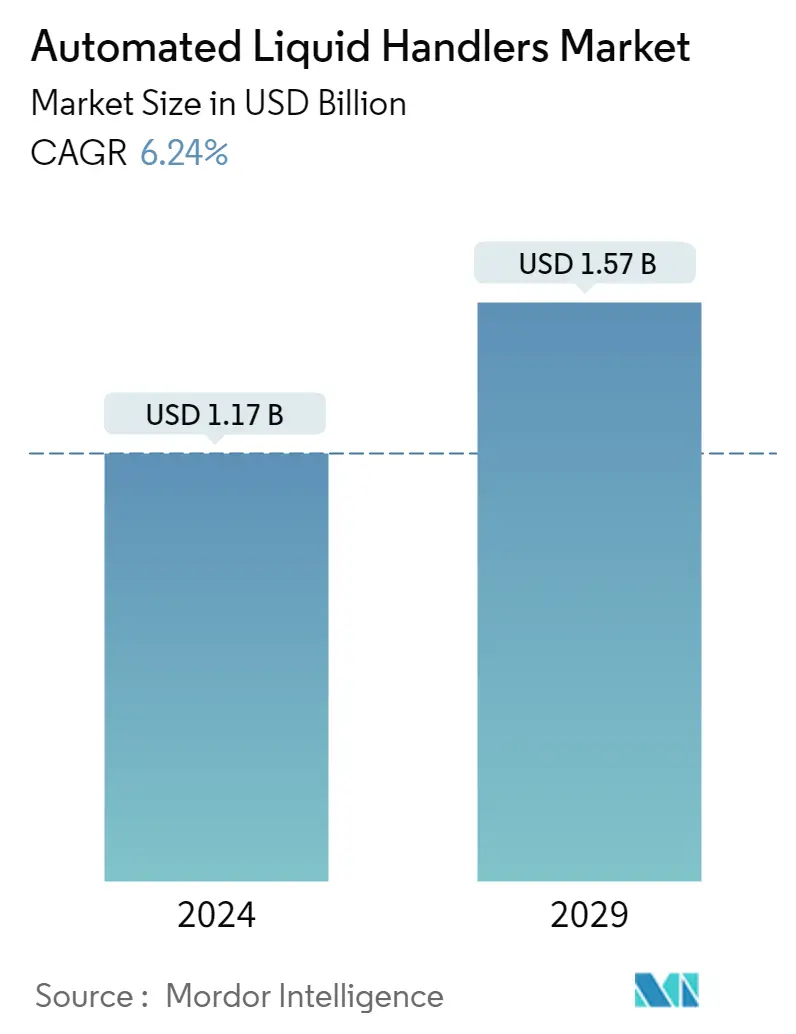
| Study Period | 2019 - 2029 |
| Market Size (2024) | USD 1.17 Billion |
| Market Size (2029) | USD 1.57 Billion |
| CAGR (2024 - 2029) | 6.24 % |
| Fastest Growing Market | Asia Pacific |
| Largest Market | North America |
Major Players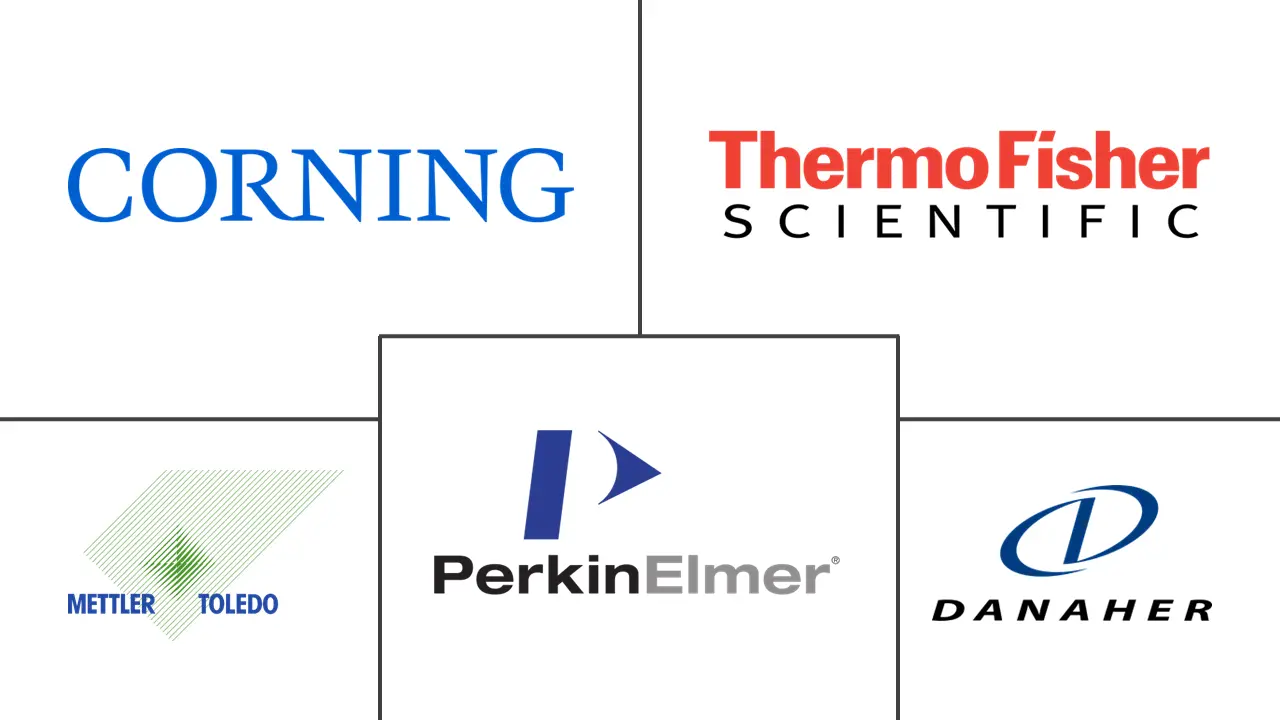
*Disclaimer: Major Players sorted in no particular order |
Need a report that reflects how COVID-19 has impacted this market and its growth?
Automated Liquid Handlers Market Analysis
The Automated Liquid Handlers Market size is estimated at USD 1.17 billion in 2024, and is expected to reach USD 1.57 billion by 2029, growing at a CAGR of 6.24% during the forecast period (2024-2029).
With the outbreak of COVID-19, the automated liquid handler market witnessed a significant increase in demand due to the increasing requirement for testing, tracing, and tracking in diagnostic labs globally. As the volume of incoming samples, especially related to the pandemic situation, laboratories need many capabilities to test up to thousands of samples daily.
- Automation systems' flexibility and adaptability made automated liquid handlers' equipment widely used in lab automation. They reduce processing time and the possibility of sample contamination by dispensing dead volumes efficiently. Liquid handlers can work with volumes as small as nanoliters, making them helpful in dispensing operations.
- There is a wide range of automated liquid handling systems on the market. They are air-based or liquid-filled systems for pipetting with either/or a combination of fixed and disposable tips. Automation platforms with liquid detection systems record aspiration action and assist when bioanalytical sample volumes are low.
- Furthermore, the rapid expansion of several clinical and pre-clinical studies worldwide, particularly in the United States, has created a need for speed in sample analysis. The machines in clinical studies run continuously and require a large workforce to ensure proper operation. Furthermore, the rapid spread of existing diseases and the discovery of new diseases raises the demand for early treatments and diagnoses. This is expected to boost the rate of clinical diagnostic application, fueling the adoption of automated liquid handlers.
- Furthermore, in January 2021, SPT Labtech acquired Apricot Designs. Through this purchase, SPT aimed to extend its range of liquid handling technologies as part of its collection of automation resolutions for structural biology, drug discovery, sample managing, genomics, biobanking, and cryo-electron microscopy. Such developments are anticipated to further drive the market growth.
- The increasing need for faster turn-around times (TAT), higher throughput, reduced human errors, and lower operational costs are some of the major factors driving the adoption of automated liquid handlers. Liquid handlers are typically employed in biochemical and chemical laboratories. Automatic liquid handling robots aid in the dispensing of samples and other liquids in laboratories. Liquid handlers use a software controller and an integrated system to customize handling procedures for large transfer volumes.
- Further, in June 2021, the German laboratory Merck announced its plan to invest EUR 175 million in France. About EUR 50 million was invested in the Gironde laboratory, which planned to triple its production, specializing in drugs derived from biotechnologies to treat cancer.
- Furthermore, advanced liquid handling technologies, such as automatic positive displacement pipetting systems, allow users to handle highly viscous to highly volatile liquids in lower volume ranges and with a broader range of liquid types. Beckman Coulter has introduced a new line of scalable liquid handling solutions for genomic, cellular, protein, and other workflows. The newly released Biomek 4000 Automated Liquid Handler aids in standardizing daily pipetting routines, preserving sample quality, and generating repeatable and reliable results.
Automated Liquid Handlers Market Trends
This section covers the major market trends shaping the Automated Liquid Handlers Market according to our research experts:
Clinical Diagnostics to Witness Significant Growth
- Automation in medical laboratories has been witnessing an increasing trend, including research and diagnostic laboratories, such as clinical chemistry, hematology, and molecular biology. Modular laboratory automation is widely employed in clinical diagnostics for various applications that include sample preparation, distribution, screening, and archiving. Further, year to year, growth in funding provided by NIH (National Institutes of Health) in clinical research is significantly driving the market.
- Clinical diagnostics have been proven beneficial in treating infectious and chronic disease conditions. World health organization (WHO) estimates that chronic disease conditions, like cardiovascular diseases, cancer, and respiratory diseases, are responsible for about 38 million people every year, accounting for 62% of all deaths worldwide.
- Moreover, according to the National Institutes of Health, clinical research funding in 2022 is expected to be around 18.32 billion US dollars, which is expected to drive market growth in the future.
- Statistics from American Heart Association indicate that about 2,300 Americans die of cardiovascular diseases each day, an average of 1 death every 38 seconds, thus indicating the need to treat them and find a solution via clinical diagnostics research.
- According to Roche Holding AG, a leading pharmaceutical company, clinical diagnostics play a crucial role in disease prevention, detection, and management. Though they account for just 2% of healthcare spending, they influence roughly two-thirds of clinical decision-making. Implementation of automation for clinical diagnostics is quite challenging as the processes need continuous, high-quality customer service. This is very important to obtain reliable test results and to provide patient safety.
- Further, in May 2022, according to data from the Ministry of Commerce and Industry, the hospitals and diagnostic centers sector in India experienced a 39% increase in Foreign Direct Investment (FDI) fund infusion during the fiscal year 2021-22, with fund infusion totaling approximately USD 697.5 million, this is expected to provide positive boost to the market growth.
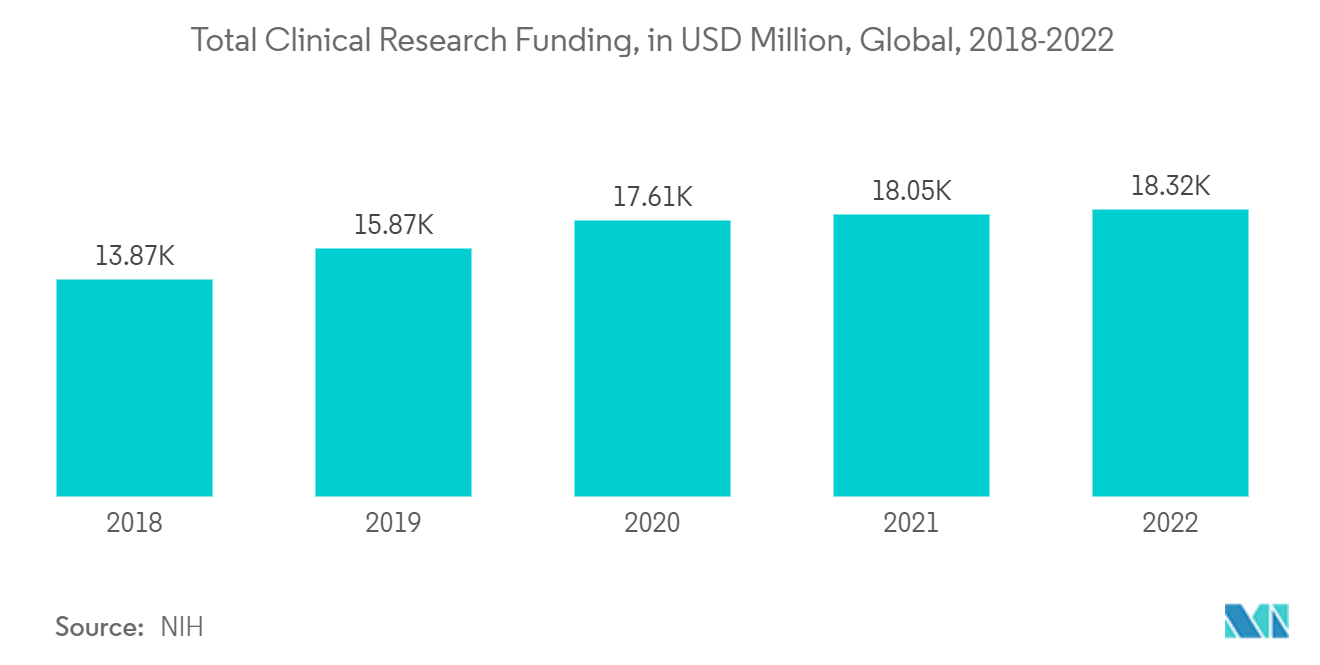
North America Accounts For Largest Market Share
- Automated liquid handling solution providers in North America continuously innovate to integrate a maximum number of clinical equipment. Further, according to the Foundation-Keybridge Equipment & Software Investment Momentum Monitor, US investment in clinical equipment increased at a 0.7% annualized rate in Q2 2021 and was up 19% year over year in August 2021.
- Besides, the United States faces a shortfall in laboratory scientists and lab personnel, which is expected to spearhead lab automation across the country. The Department of Labor and Statistics predicts a future shortage of more than 150,000 clinical laboratory scientists exacerbated by a wave of retirements that would see much-qualified personnel leave the workforce over the coming years. Around 5,000 American lab professionals enter the labor pool each year, less than half of the approximately 12,000 workers a year necessary to meet the rising demand for their services.
- Due to the developments in the field of R&D, many public institutions are expected to enhance their laboratory capabilities across the country, boosting the demand for lab automation equipment. For instance, final commissioning is underway at the U.S. Army Medical Research Institute of Infectious Diseases (USAMRIID) in Fort Detrick in Frederick, Maryland. The building is anticipated to be open for occupancy in 2021. This 835,000-square-foot building is expected to serve as the lead facility for the U.S. Biological Defense Research Program.
- Furthermore, strict regulations imposed by the U.S. government and the FDA, along with the growing demand in the diagnostic market with the increasing emphasis on drug discovery and research laboratories owing to the rising presence of various diseases such as cardiovascular diseases and neurological diseases in the region, fueled the demand of drug discovery and clinical diagnostics sector.
- New lab infrastructure setup has been accelerated in the region. For instance, in April 2021, Analytik Jena, a leading provider of high-end analytical measuring technology, announced the opening of its applications lab within the Endress+Hauser campus. The lab aimed to offer a centralized location in the United States for in-house customer support and demonstrations. This lab is set to provide demos to showcase the precision and accuracy of Analytik Jena instruments in liquid handling and automation, chemical analysis, and life science groups.
- The trend towards new software innovation solutions and expansion has translated the demand for automated liquid handlers market in the region, leading to dominating the North American and the global markets.
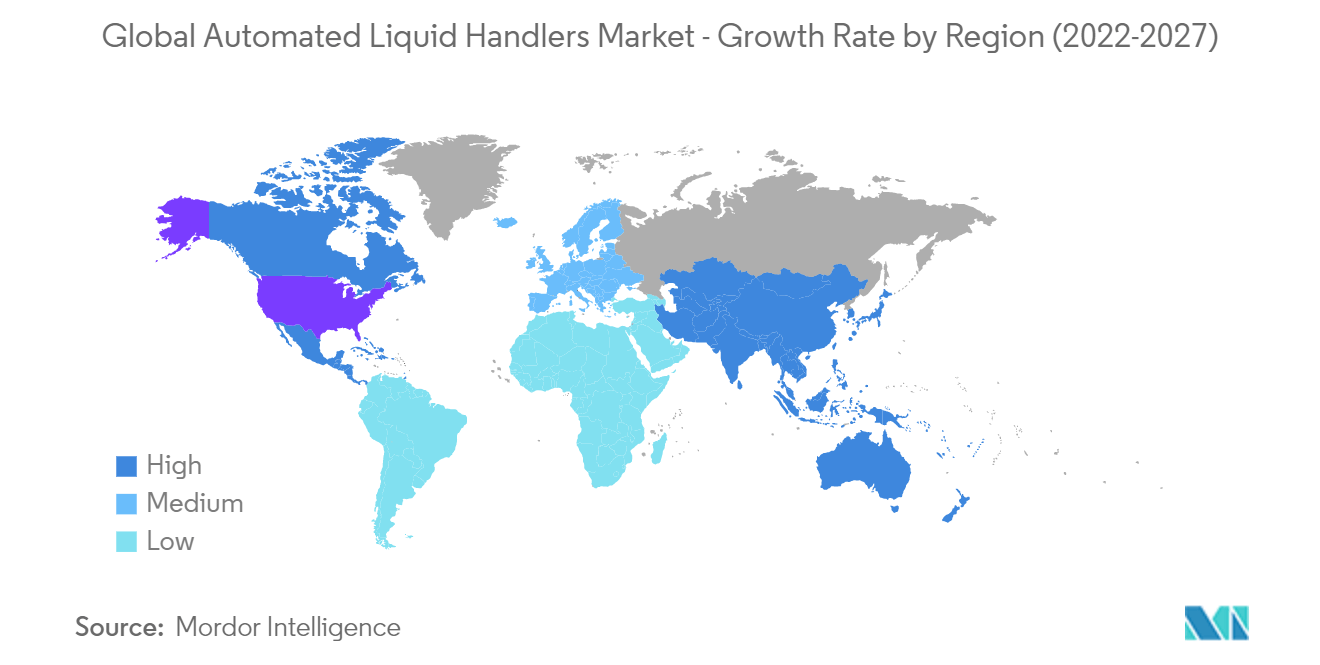
Automated Liquid Handlers Industry Overview
The Automated Liquid Handlers Market is moderately fragmented due to the presence of a few prominent players, and newly added startups and partnership innovations are increasing new rivalry in the market. Thermo Fisher Scientific, Perkin Elmer Inc., Beckman Coulter Inc., Corning Inc., and others are key market players. Product innovation, partnerships, and acquisition are vital developments to increase their market share.
- February 2022 - SPT Labtech, a laboratory automation specialist for life sciences, debuted the apricot DC1, a 4-in-1 automated liquid handling platform, at the SLAS 2022 International Conference and Exhibition in Boston. The launch introduces a compact automatic pipettor to help laboratories streamline daily manual or semi-manual pipetting processes across applications.
- Match 2021 - QIAGEN N.V. announced the global launch of the QIAcube Connect MDx, a flexible platform for automated sample processing available to molecular diagnostic laboratories in the U.S. and Canada, the European Union, and other markets worldwide.
Automated Liquid Handlers Market Leaders
Thermo Fisher Scientific Inc.
Perkin Elmer Inc.
Mettler-Toledo International Inc.
Corning Inc.
Danaher Corporation
*Disclaimer: Major Players sorted in no particular order
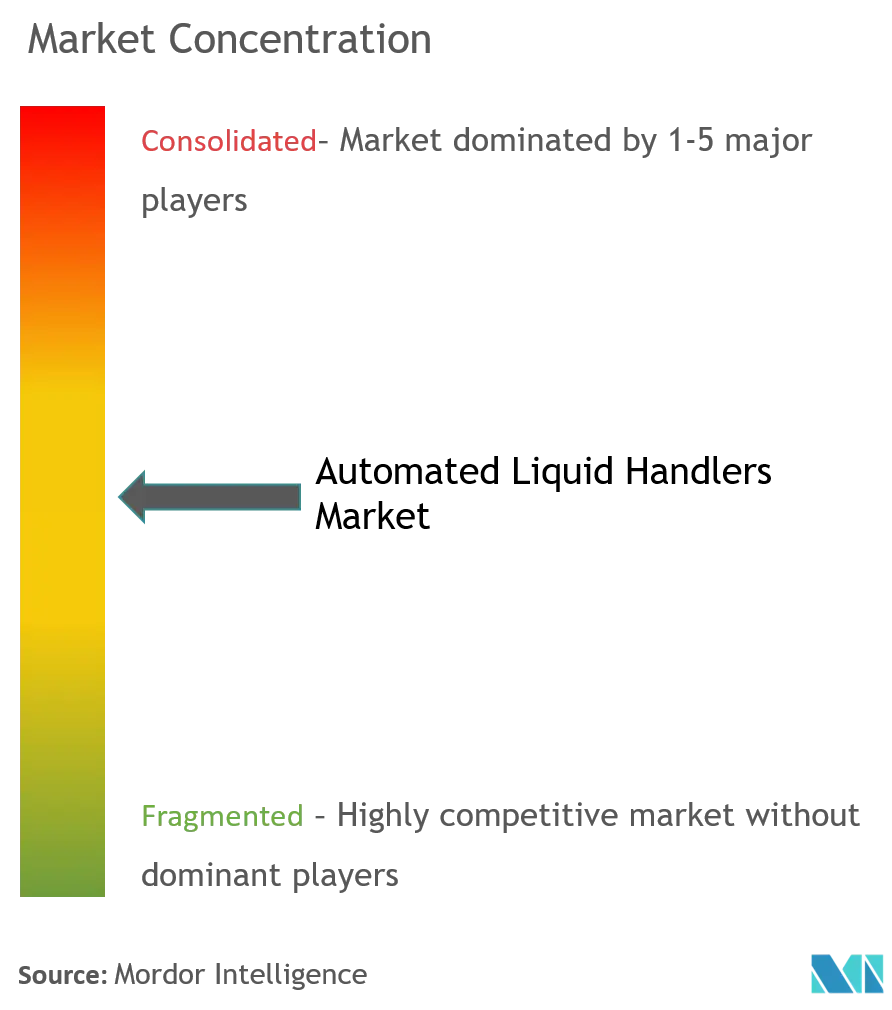
Automated Liquid Handlers Market News
- February 2022 - DISPENDIX, a BICO company, announced the introduction of the I.DOT HT Non-contact Dispenser and the L.DROP Liquid Handler at SLAS 2022. The initiative was taken in line with the company's goal to commoditize laboratory automation.
- March 2021 - Beckman Coulter Life Sciences introduced the Biomek NGeniuS workstation, its newest automated liquid handler, at the virtual Advances in Genome Biology and Technology (AGBT) General Meeting. The Biomek NGeniuS workstation is a purpose-built liquid handler for NGS library practice that reduces manual transfers and hands-on time for the traditionally labor-intensive process of library construction to advance next-generation sequencing (NGS) technology.
- February 2021 - The Thermo Fisher Scientific Amplitude Solution is a new, highly automated molecular diagnostic testing system capable of analyzing up to 8,000 COVID-19 specimens in 24 hours. Using the design, laboratories are rapidly scaling their COVID-19 testing workflows to the volumes needed to help reduce the spread of disease and restore economies and communities.
Automated Liquid Handlers Market Report - Table of Contents
1. INTRODUCTION
1.1 Study Assumptions and Market Definition
1.2 Scope of the Study
2. RESEARCH METHODOLOGY
3. EXECUTIVE SUMMARY
4. MARKET INSIGHTS
4.1 Market Overview
4.2 Industry Value Chain Analysis
4.3 Industry Attractiveness - Porter's Five Forces Analysis
4.3.1 Bargaining Power of Suppliers
4.3.2 Bargaining Power of Buyers
4.3.3 Threat of New Entrants
4.3.4 Intensity of Competitive Rivalry
4.3.5 Threat of Substitutes
4.4 Assessment of the Impact of COVID-19 on the Market
5. MARKET DYNAMICS
5.1 Market Drivers
5.1.1 Flexibility and Adaptability of Lab Automation Systems
5.2 Market Restraints
5.2.1 Slower Adoption Rates in Small- and Medium-sized Organizations
6. MARKET SEGMENTATION
6.1 By Application
6.1.1 Drug Discovery
6.1.2 Cancer and Genomic Research
6.1.3 Biotechnology
6.1.4 Other Applications
6.2 By End-user Vertical
6.2.1 Contract Research Organizations
6.2.2 Pharmaceutical and Biotechnology
6.2.3 Academic and Research Institutes
6.3 By Geography
6.3.1 North America
6.3.2 Europe
6.3.3 Asia Pacific
6.3.4 Latin America
6.3.5 Middle East and Africa
7. COMPETITIVE LANDSCAPE
7.1 Company Profiles
7.1.1 Thermo Fisher Scientific
7.1.2 Perkin Elmer Inc.
7.1.3 Danaher Corporation (Beckman Coulter Inc.)
7.1.4 Formulatrix Inc.
7.1.5 Mettler-Toledo International Inc.
7.1.6 Agilent Technologies Inc.
7.1.7 Hamilton Company
7.1.8 Becton Dickinson and Company
7.1.9 Synchron Lab Automation
7.1.10 Tecan Group Ltd
7.1.11 Aurora Biomed Inc.
7.1.12 Eppendorf AG
7.1.13 Analytik Jena AG (Endress+Hauser Group Services AG)
7.1.14 Hudson Robotics Inc.
- *List Not Exhaustive
8. INVESTMENT ANALYSIS
9. FUTURE OF THE MARKET
Automated Liquid Handlers Industry Segmentation
The market studied has been segmented based on Applications such as Drug Discovery, Cancer and Genomic Research, and Biotechnology, among various others, End-User verticals such as Contract Research Organizations, pharmaceuticals, and Biotechnology, and Academic and Research Institutes in different geographies. The study also covers the impact of COVID-19 on the market.
| By Application | |
| Drug Discovery | |
| Cancer and Genomic Research | |
| Biotechnology | |
| Other Applications |
| By End-user Vertical | |
| Contract Research Organizations | |
| Pharmaceutical and Biotechnology | |
| Academic and Research Institutes |
| By Geography | |
| North America | |
| Europe | |
| Asia Pacific | |
| Latin America | |
| Middle East and Africa |
Automated Liquid Handlers Market Research FAQs
How big is the Automated Liquid Handlers Market?
The Automated Liquid Handlers Market size is expected to reach USD 1.17 billion in 2024 and grow at a CAGR of 6.24% to reach USD 1.57 billion by 2029.
What is the current Automated Liquid Handlers Market size?
In 2024, the Automated Liquid Handlers Market size is expected to reach USD 1.17 billion.
Who are the key players in Automated Liquid Handlers Market?
Thermo Fisher Scientific Inc., Perkin Elmer Inc., Mettler-Toledo International Inc., Corning Inc. and Danaher Corporation are the major companies operating in the Automated Liquid Handlers Market.
Which is the fastest growing region in Automated Liquid Handlers Market?
Asia Pacific is estimated to grow at the highest CAGR over the forecast period (2024-2029).
Which region has the biggest share in Automated Liquid Handlers Market?
In 2024, the North America accounts for the largest market share in Automated Liquid Handlers Market.
What years does this Automated Liquid Handlers Market cover, and what was the market size in 2023?
In 2023, the Automated Liquid Handlers Market size was estimated at USD 1.10 billion. The report covers the Automated Liquid Handlers Market historical market size for years: 2019, 2020, 2021, 2022 and 2023. The report also forecasts the Automated Liquid Handlers Market size for years: 2024, 2025, 2026, 2027, 2028 and 2029.
Automated Liquid Handling Industry Report
Statistics for the 2024 Automated Liquid Handling market share, size and revenue growth rate, created by Mordor Intelligence™ Industry Reports. Automated Liquid Handling analysis includes a market forecast outlook to 2029 and historical overview. Get a sample of this industry analysis as a free report PDF download.
